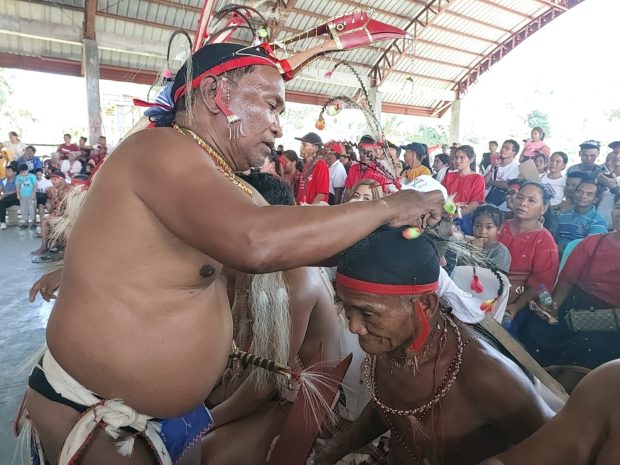
THANKSGIVING | Some Bugkalot tribesmen enjoy a day of thanksgiving as they celebrate the first Bugkalot-Ilongot Day with fellow tribespeople, the Ilongot, in Landingan, Nagtipunan, Quirino province, on July 23, which marks the day their certificate of ancestral domain title was awarded six years ago. (Photo by VILLAMOR VISAYA JR. / Inquirer Northern Luzon)
NAGTIPUNAN, Quirino, Philippines —Two thousand indigenous Bugkalot and Ilongot folk from the provinces of Quirino, Aurora and Nueva Vizcaya in Cagayan Valley region trooped to Landingan village here on Saturday to celebrate their first Bugkalot-Ilongot Day.
The tribes held a get-together to strengthen their unity and to jointly celebrate their being holders of a certificate of ancestral domain title (CADT), which they received in 2016, for their ancestral lands totaling 212,773.47 hectares located in Nagtipunan, Quirino; Maria Aurora and Dipaculao, Aurora; and Dupax Del Norte, Kasibu, Dupax Del Sur and Alfonso Castañeda, Nueva Vizcaya.
Rosario Camma, Bugkalot chieftain, said the challenges facing indigenous people like them were just but a “binding force” to unite and affirm their ownership of the ancestral lands awarded to them by the government through the National Commission on Indigenous Peoples (NCIP) six years ago, on July 23, 2016.
A CADT is a title formally recognizing the rights of possession and ownership of indigenous peoples over their ancestral domains identified and delineated in accordance with Republic Act No. 8371 (Indigenous Peoples’ Rights Act of 1997).
For future generation
THANKSGIVING | Some Bugkalot tribesmen enjoy a day of thanksgiving as they celebrate the first Bugkalot-Ilongot Day with fellow tribespeople, the Ilongot, in Landingan, Nagtipunan, Quirino province, on July 23, which marks the day their certificate of ancestral domain title was awarded six years ago. (Photo by VILLAMOR VISAYA JR. / Inquirer Northern Luzon)
“We have to nurture the ancestral lands for the future generation. We have to take care [of it],” Camma said.
Camma added that they needed to protect their domain as there were still claimants to some portions of their ancestral lands.
Some of their lands have also been attracting tourists, such as the Landingan Viewpoint, which offers a panoramic and scenic view of Nagtipunan. At least 81 Bugkalot have been working at the site, which was developed by the municipality.
Johnlye Pasigien, Ilongot tribal leader, said the lack of livelihood opportunities has been a recurring problem among the Ilongot, especially during the pandemic, and they were now asking for assistance to find scholarship grants for young Bugkalot-Ilongot students.
Although they are of the same origin, the tribe in Quirino is recognized by the name of Bugkalot, while the tribe outside the province is still called by the old name Ilongot.
But both tribes share a history of headhunting tradition, which was exercised as a rite of passage that marked manhood.
They were known as fierce tribespeople who went on headhunting raids in settlements around their areas up until the 1950s.
The NCIP reported that in 2016, the population of Bugkalot-Ilongot has gone down to only around 15,000 in Northern Luzon, a sharp decline from the 50,786 recorded in 1990. The reason for the decline was the assimilation of tribespeople by marriage to locals, leading them to abandon their culture and origin.
RELATED STORY
Keeping Ibaloy history and heritage alive
How Tagbanua tribesmen protect the ‘mermaids’ of Palawan
Subanon pay tribute to tribe’s gatekeeper